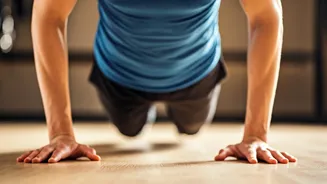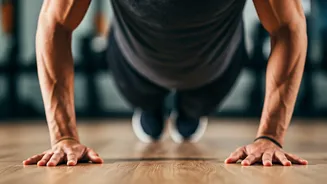Why Push-Ups Matter
Push-ups are much more than just a gym exercise; they are a fundamental movement that benefits your overall fitness. They are a potent workout, engaging
multiple muscle groups in the upper body and core. Regularly performing push-ups can greatly improve upper body strength, enhance core stability, and contribute to bone health. These exercises can be done almost anywhere, making them a readily accessible part of any fitness routine. Furthermore, push-ups are adaptable, making them suitable for various fitness levels, from beginners to experienced athletes, by modifying the difficulty.
Avoiding Common Pitfalls
One of the most frequent mistakes in push-ups is focusing on quantity rather than quality. Many people rush to complete as many repetitions as possible without establishing proper foundational strength or concentrating on form. This often results in incorrect body alignment, such as sagging hips, flaring elbows, or an incomplete range of motion. Dr. Vajalla Shravani, a fitness expert, suggests breaking push-ups into progressions to avoid these issues. Starting with wall or incline push-ups before advancing to knee push-ups and eventually full push-ups is crucial for building a strong base. Strength training that targets the chest, shoulders, triceps, and core also complements push-up practice.
Step-by-Step Technique
To perform push-ups correctly, start in a plank position, hands positioned slightly wider than shoulder-width apart. Activate your core muscles by drawing your navel towards your spine. Inhale as you lower your body towards the floor and exhale as you push back up. Keep your elbows close to your body as you lower yourself, and lower your chest until it's just above or lightly touching the ground. Maintain a neutral head position by looking at a spot on the floor about a foot in front of you. Focus on muscle engagement throughout the movement, avoiding jerky motions, and performing each repetition with control.
Push-Up Progressions
For beginners, wall push-ups offer a gentle introduction. Place hands on a wall, slightly wider than shoulder-width apart, and lean in, keeping your body straight. Next, incline push-ups are performed by placing your hands on an elevated surface like a bench or step, which reduces the resistance. Knee push-ups are another modification, where you perform the push-up from your knees, maintaining a straight line from your head to your knees. These progressions gradually build strength, allowing you to move towards standard push-ups without overexerting your muscles. With each stage, focus on maintaining good form and controlled movements.
The Role of Rest
Recovery is a crucial aspect often overlooked in fitness. Muscles need time to repair and grow stronger. Consistently pushing through fatigue might hinder progress. Aim for structured training, such as three to four sessions weekly, with rest days and mobility work in between. This approach builds both performance and longevity. Incorporating rest days allows your muscles to recover, preventing overtraining and reducing the risk of injuries. Proper rest and recovery are as important as the workouts themselves.
Modifications for Safety
Individuals with pre-existing conditions should modify push-ups to avoid aggravating injuries. Those with shoulder injuries should avoid direct push-ups and focus on progressions that slowly build strength in the shoulder area. Similarly, those with lower back injuries should exercise caution when attempting planks, following a progression that gradually strengthens core muscles without placing excessive strain on the lower back. Always listen to your body and modify exercises as needed. Consulting a healthcare professional or fitness expert is recommended for personalized guidance.









